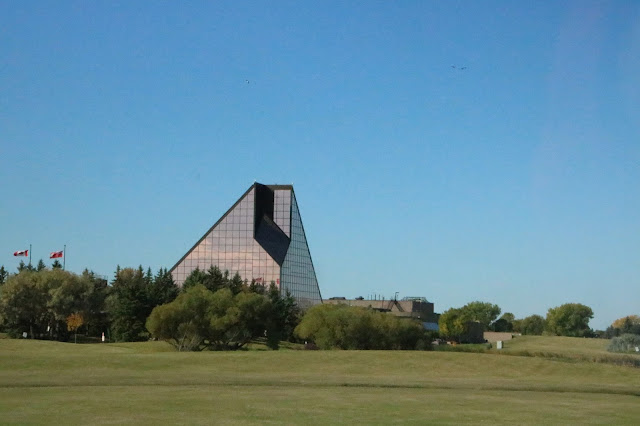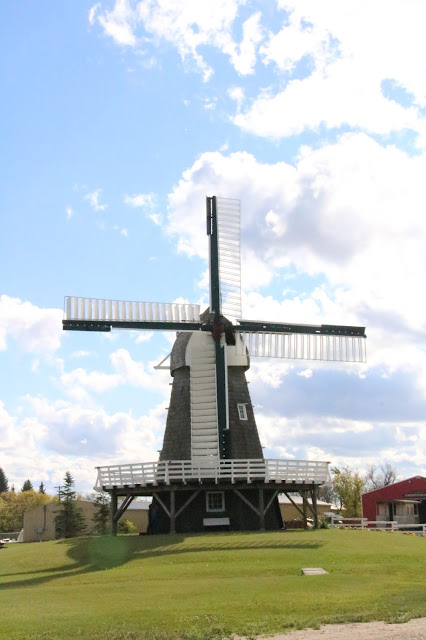September 2017
We headed to downtown Winnipeg because a photo at Portage and Main is on my bucket list. Why? Later...
The University of Winnipeg’s Richardson College for the Environment and Science Complex has the Periodic Table grid on the side of the building. This building has 30 research and teaching labs, a rooftop greenhouse and also a restaurant, aptly named “Elements”.
We headed to downtown Winnipeg because a photo at Portage and Main is on my bucket list. Why? Later...
In 1881, the city’s first HBC retail store was completed at the corner of Main Street and York Avenue. The front section was used for retail business, while the back and upper floors were used for the storage of furs and general merchandise. Additions were built from time to time for office purposes. In 1911, a large, modern, fire-proof building was erected across the street, where the General Offices of the Company, as well as the Wholesale, Land, and Fur Trade Departments were housed. This became known as Hudson’s Bay House.
By 1910, it was already evident that the heart of Winnipeg’s shopping district had relocated to Portage Avenue. HBC’s retail strategy at that time was to invest in the development of large modern department stores to service the growing population of the west. In the case of Winnipeg, this meant building a brand-new store in a brand-new location.
Just one block north of Portage and Main, the Exchange District comprises twenty city blocks and approximately 150 heritage buildings, and it is known for its intact early 20th century collection of warehouses, financial institutions, and early terra cotta clad skyscrapers.
The Exchange District’s name originates from the Winnipeg Grain Exchange, the former centre of the grain industry in Canada, as well as other commodity exchanges which developed in Winnipeg between 1881–1918, some of which are still active today.
Bailey's Restaurant & Lounge building has borne witness to the growth and the seasons of Winnipeg. It has stood through the violence of the 1919 General Strike and the ravages of the 1950 Red River flood waters. It has witnessed the evolution of the most famous intersection in Canada, Portage and Main, and has seen the construction of the corporate towers at the heart of Winnipeg's business district.
North Watch by Manitoba artist Ivan Eyre
.
Seal River Crossing
This bronze sculpture by renowned Manitoba artist and sculptor Peter Sawatzky was inspired by his many visits to Canada's North. It was there that Peter was able to observe the majestic Caribou crossing the northern tundra and navigating the fast-moving waters of the Seal River.
Seal River Crossing was commissioned in 2007 by James Richardson & Sons, Limited in celebration of their 150th Anniversary in Canadian business.
The sculpture depict seven caribou crossing the Seal River with the first three starting to climb out of the river.
We use the pedestrian underpass to get over to the Bank of Montreal at Portage and Main.
.
Bank of Montreal
The corner is well-known across Canada as the "crossroads of Canada", due to its relative proximity to the longitudinal centre of Canada.
We later see a sign on the Trans-Canada Highway at 96°48'35"W proclaiming it the longitudinal centre of Canada in effect, the north-south line midway between the extreme points of Canada on the east and west, including islands (including Newfoundland since 1949). This is 20 minutes west of the location given by the Atlas of Canada, however.
Portage and Main is the brunt of popular jokes referring to it as the coldest and windiest intersection in Canada. The phrase Portage and Main has come to refer to the city of Winnipeg as a whole. The long-standing cold weather legend is unproven, because there are no official temperature measurements at any street corner in Canada to confirm the coldest intersection.
Back over to the Exchange District.
Designed by Winnipeg architect J. D. Atchison, this building was one of four major banks on “Bankers’ Row” along Main Street. It was the last major office building erected during the city’s early boom period, and served as the Manitoba headquarters of the Bank of Hamilton which merged with the Bank of Commerce in 1923.Short drive today so we ambled along.
As we're leaving town I spot a cool looking building. Then I saw the sign for the Royal Canadian Mint. And we decided to check it our having no idea if it was open to the public.
As you approach The ‘Parade of Flags’ lines the driveway leading into the Mint representing the 75 countries for which the facility has manufactured coins since it opened in 1976.
Tthe Mint’s Winnipeg facility has produced centavos for Cuba, kroner for Norway, fils for Yemen, pesos for Colombia, kroner for Iceland, baht for Thailand, and a thousand-dollar coin for Hong Kong. Other client nations include Barbados, New Zealand and Uganda.
He was also involved with The Forks as Site Planning Manager and Architectural Advisor, which is the bridge I showed you yesterday beside the Human Rights Museum. It also looks like a mountain.
There is a whimsical loon sitting ourside. Our one dollar coin, the loonie, is named after the bird.
Entrance was free as guided tours are in the afternoon. But we were given a quick overview by an employee and then left to roam on our own.
No photos allowed for the security and privacy of the employees and the equipment. But I did find one online.
The Mint has 365 staff with approximately 200 to 250 of those working in the high-security area of the plant, where circulation coins are produced.
The Mint produces and markets a family of high purity gold, silver, palladium and platinum Maple Leaf bullion coins, wafers and bars for the investment market as well as gold and silver granules for the jewellery industry and industrial applications. The Mint also provides Canadian and foreign customers with gold and silver processing, including refining, assaying and secure storage.
Recently, up to two billion Canadian circulation coins are struck each year at the Mint’s facility in Winnipeg. While the effigy of the reigning monarch has appeared on every Canadian coin produced by the Mint since 1908, reverse designs have changed considerably over the years. The Mint often introduces new commemorative designs which celebrate Canada’s history, culture and values.
Yet another stop, which included lunch, that was on today's agenda.
The Mennonite Heritage Village brings to life the Mennonite way of life from the 16th century to the present day.
The forty acre (17 hectare) site spreads out from a village street, in a pattern reminiscent of Mennonite villages found throughout Southern Manitoba at the turn of the previous century. The north side of the street illustrates the early settlement buildings while the south side shows the gradual shift to various business enterprises.
We soon cross into Ontario!! It is hard to believe that it will take four nights of hotels in Ontario before we get home. We could have done it in three, but that would have meant not seeing what we want.
We spotted many inuksuit built upon the rocks along the highway.
The inuksuk may have been used for navigation, as a point of reference, a marker for travel routes, fishing places, camps, hunting grounds, places of veneration, drift fences used in hunting or to mark a food cache.
A large number of inuksuit have been built in some areas along the Trans-Canada Highway, including Northern Ontario. In 2010, a journalist from Sudbury's Northern Life counted 93 inuksuit along Highway 69 between Sudbury and Parry Sound.
A bigger one we spotted.
We ate lunch in Thunder Bay but that was it.
Kenora looks like a nice spot.
Kenora was once known as Rat Portage and this mural illustrates the Rat Portage Bicycle Club assembling for a parade that was held to celebrate Queen Victoria's 60th Year on the throne in 1897.
Our destination.
Max the Moose is a roadside attraction – a 5.6 metre high Moose statue and mascot of town. Max is near a tourist information centre, and is celebrated each year during the MooseFest event with live music, outdoor sports and a fishing tournament and more.
Day 1 - Toronto to Chesterton IN
Weekly recap with more photos
Day 5 - Denver CO to Rapid City SD
The Curtis Hotel Denver CO funky themed floors
Day 6 - Rapid City SD Mount Rushmore City of Presidents
Day 7 - Rapid City SD to Billings MT Crazy Horse and Little Big Horn
Day 8 - Billings MT to Driggs ID
Day 9 - Jackson Hole WY and Grand Teton NP
Day 5 - Denver CO to Rapid City SD
The Curtis Hotel Denver CO funky themed floors
Day 6 - Rapid City SD Mount Rushmore City of Presidents
Day 7 - Rapid City SD to Billings MT Crazy Horse and Little Big Horn
Day 8 - Billings MT to Driggs ID
Day 9 - Jackson Hole WY and Grand Teton NP
Day 13 - Port Angeles WA to Victoria BC
Day 14 - Victoria BC
Day 15 - Victoria BC to Olympia WA
Weekly Recap
Day 16 - Olympia WA to Vancouver BC
Day 17 - Vancouver BC to Kamloops BC
Day 18 - Kamloops BC to Jasper AB
Day 19 Jasper AB to Edmonton AB
Day 20 - Edmonton AB to Medicine Hat AB
Day 21 - Medicine Hat AB to Regina SK
Day 22 - Regina SK to Brandon MB
Day 23 - Brandon MB to Winnipeg MB
Day 24 - Winnipeg MB to Dreyden MB
Day 14 - Victoria BC
Day 15 - Victoria BC to Olympia WA
Weekly Recap
Day 16 - Olympia WA to Vancouver BC
Day 17 - Vancouver BC to Kamloops BC
Day 18 - Kamloops BC to Jasper AB
Day 19 Jasper AB to Edmonton AB
Day 20 - Edmonton AB to Medicine Hat AB
Day 21 - Medicine Hat AB to Regina SK
Day 22 - Regina SK to Brandon MB
Day 23 - Brandon MB to Winnipeg MB
Day 24 - Winnipeg MB to Dreyden MB





































































The architecture in Winnipeg is quite striking, and that caribou sculpture really impresses me.
ReplyDeleteI knew nothing at all about Winnipeg - interesting about Portage and Main,
ReplyDelete